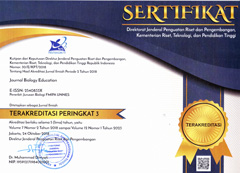Development of E-Atlas Anatomy of the Vertebrate Digestive System as a Teaching Material Supplement to Improve Student Learning Outcomes
Keywords:
E-Atlas , Learning outcomes, Digestive system, Teaching suplement, VertebratesAbstract
This study aims to analyze the validity, practicality, and effectiveness of the E-Atlas Anatomy of the Vertebrate Digestive System as a Teaching Material Supplement to Improve Learning Outcomes of High School Students. This research design is Research and Development (R&D) with ADDIE model (Analysis, Design, Development, Implementation, Evaluation). The subjects of this study were students of class XI SMA Negeri 14 Semarang. Data collection methods include interviews, student needs analysis questionnaires, media expert and matero expert validation questionnaires, teacher and student response questionnaires, and pretest-posttest questions. The results showed that the product developed in the form of E-Atlas contains anatomy and mechanism of the digestive system of humans and vertebrate animals, differences in the digestive system of humans and vertebrate animals, anatomical images of digestive system organs, and videos of digestive system mechanisms. Media validity with a very valid category (96%), material validation with a very valid category (87%), teacher responses with a practical category (77%) and students with a very practical category (85%), classical student completeness results 55%, n-gain test results 0.57 or 57% with a moderate category, and t-test results 0.000 which shows there is a significant average difference between pretest and posttest scores. This study can be concluded that the E-Atlas Anatomy of the Vertebrate Digestive System is valid, practical and effective to be used as a supplement to digestive teaching materials to improve high school learning outcomes.





